To finish off our monthly theme of healthy fur/feathers/scales we are talking about our reptilian friends!
Reptiles have very unique skin that is formed into scales. Many people are under the impression that reptile skin is ‘slimy’ – this couldn’t be further from the truth, as they actually have very few skin glands! They are unable to sweat, and control their body temperature by moving around within a temperature gradient (this is one of the reasons it is so important to provide appropriate temperatures to your reptile). Healthy skin is shed regularly as a reptile grows – some species shed in one large piece (e.g. snakes), and others in small pieces (lizards, turtles).
We see a lot of health issues associated with reptile skin, and it is very important to regularly monitor it as a responsible reptile owner. Things such as retained shed (shed skin getting stuck), blisters, wounds and lumps all are abnormal and should be addressed.
The following skin conditions are seen quite commonly in practice. Any abnormality that has you concerned warrants attention so feel free to call the clinic today to discuss if a visit is necessary – 07 3217 3533.
Burns
Burns are encountered very frequently in reptiles. Fortunately most burns are easily preventable through appropriate husbandry. Burns are most common in snakes, however can occur in any reptile. They are mostly caused by inappropriate heat sources such as heat mats, heat rocks or unprotected heat lights. Reptiles seek heat when they are trying to raise their body temperature and will often wrap around/touch heat globes that are not surrounded by a protective cage, or sit for long periods on heat rocks or heat mats, which produce an intense heat. This unfortunately can result in significant burns to the skin – in severe cases resulting in burns through the body wall. Burns are most commonly seen after the winter months, as reptiles will be trying to heat themselves over this period. The most effective way to prevent burns is by providing a radiant heat source such as a ceramic or infrared globe and surround it by a protective cage – this will stop your reptile from touching the light and causing a burn. It is also imperative that heat sources are attached to thermostats to ensure they provide appropriate hot spots and they don’t overheat your enclosure.
Retained shed
Abnormal shedding or ‘dysecdysis’ occurs in reptiles for a range of different reasons. It most often occurs due to husbandry deficits or health issues. During normal skin shedding fluid is secreted by the body between the old and new skin layer – this facilitates shedding of the old skin without damage to the new skin beneath. Inappropriate humidity (too low) and inappropriate temperatures (usually too low) are most often implicated in causing dysecdysis. Other skin diseases can also interfere with normal shedding, along with malnutrition and any disease of the body resulting in dehydration. Normal shedding also requires appropriate substrate for a reptile to rub against. Retained shed can predispose to constriction injuries (of the toes or tail), skin infections (retained scutes in turtles can often result in dermatitis or ‘shell rot’). If your reptile isn’t shedding appropriately a vet visit to discuss and assess for possible aetiologies is warranted.
Dermatitis (bacterial, fungal, viral)
Dermatitis refers to inflammation of the skin, and can be caused by a number of different pathogens – such as bacteria, fungus, some viruses and parasites. Dermatitis in reptiles is often due to underlying husbandry issues – if an enclosure isn’t kept clean enough it can result in increased exposure to pathogens and increased humidity, which can both contribute to skin disease. However some pathogens don’t require husbandry issues to cause disease – certain viruses in snakes can cause skin lesions, and there are some emerging fungal pathogens in Australia causing primary disease (not requiring immunosuppression to be present first).
Mites
The reptile mite (Ophionyssus natricus) is a common parasite in reptile collections. Infection with the reptile mite has serious consequences, as the blood sucking nature of the parasite can severely debilitate individual animals. Additionally, the mite can spread diseases, such as Aeromonas bacterial infections, and is suspected in the spread of viruses.
Reptile mites are visible to the naked eye, and are initially pale, and darker after a feeding. Mite faeces can be seen as white specks on the animal or within the enclosure. Mites do not like light, so will hide in corners within the enclosure, and also in crevices within the animal’s scales and skin. They are often found around the eyes , legs (in lizards), and mouth. Some people have reported dermatitis secondary to infestation with reptile mites. Mites are highly active and can travel several metres. Mites can also transfer on clothing and reptile equipment. Once an egg is laid, the mites go through several development stages and then become adults. Females do not need a male to reproduce; even one female can cause an infestation in a collection. Mites can survive for prolonged periods off the host, especially in cooler temperatures.
As with any disease, prevention is better than treatment. Any newly acquired reptiles should be quarantined for a minimum of four months. Quarantine involves complete separation of the reptile from the rest of the collection, and ‘barrier nursing’. Barrier nursing means that any equipment used on the new reptile should not be subsequently used on the rest of the collection, and that the new reptile should always be fed, handled and cleaned AFTER the rest of the collection is done. Owners should NEVER go from the new reptile back to the other animals. If mites are suspected, a veterinary consultation is warranted.

Regular bathing can be beneficial for some reptiles to aid shedding. This bearded dragon is loving a good bath!

Regular exposure to natural sunlight is very beneficial to reptiles. It allows them to get appropriate levels of vitamin D required for calcium metabolism, and in turtles when they bask and dry out their shell it helps maintain shell health and reduces incidences of ‘shell rot’ and retained scutes. Constant monitoring of a reptile in the sun is required and they must always have access to shade– it is not recommended to take them outside for long periods on extremely hot days.

This python has retained shed on its tail – this is abnormal as snakes usually shed in one piece. In this case the shed had constricted an area of the tail that resulted in significant damage to the tail tip, resulting in it requiring amputation.

This jungle python was brought into the clinic for a severe mite infestation – you can see small black dots around the eye – sitting within the eye socket. The reptile mite – Ophionyssus natricis, is an ectoparasite that sucks blood and can transmit blood-borne diseases. It only takes a single mite to establish an infection within a collection.

This is a healing burn on the underside of a python. Unfortunately we see burns in reptiles very regularly after Winter. They are usually associated with the use of heat rocks, mats and lights that aren’t surrounded by a protective care. Reptiles will lie on and wrap around these heating elements in an attempt to raise their body temperature, but can burn their skin in the process. Radiant heat sources such as ceramic globes surrounded by a protective cage (to prevent a reptile touching the globe) are generally the safest form of heating.




